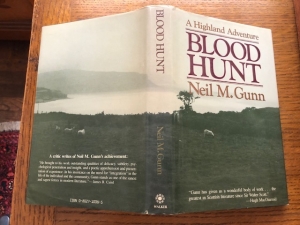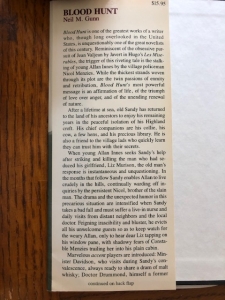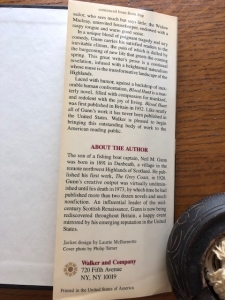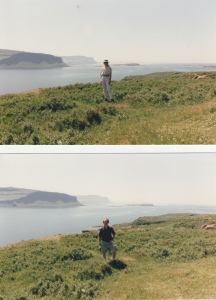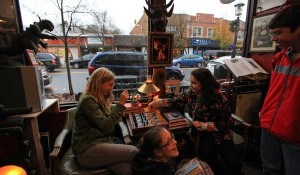Appreciating Hebridean Landscapes and the Work of Scottish Novelist Neil Gunn
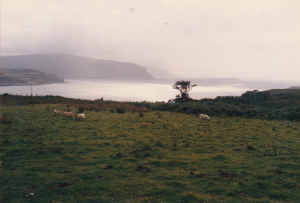 For lovers of Scotland and the Hebrides, just offshore from the stunning isle of Mull, is an even smaller island, equally beautiful and shimmering in the silvery distance, called Ulva. This post kicks off with a memorable picture I took of Ulva from Mull during a solo Scottish sojourn I made in 1986, the first of five visits I’ve made to the country. In those pre-digital days I took the photograph with film and a .35 mm Minolta camera I still own, though now use only rarely.
For lovers of Scotland and the Hebrides, just offshore from the stunning isle of Mull, is an even smaller island, equally beautiful and shimmering in the silvery distance, called Ulva. This post kicks off with a memorable picture I took of Ulva from Mull during a solo Scottish sojourn I made in 1986, the first of five visits I’ve made to the country. In those pre-digital days I took the photograph with film and a .35 mm Minolta camera I still own, though now use only rarely.
Visually, I was struck by the recognition that headlands such as these on Ulva could almost mirror each other in their profiles and their contours. I remember the silvery cloud-filled day I made this image, and a very warm day some years later, when I took more photos of Ulva; each time I felt as if the landscape had set in motion a kind of rhyming action, with cliff shapes echoing each other as they receded into the distance.
On that trip, a bookseller in Edinburgh recommended a novel, Young Art and Old Hector, by a Scottish novelist he thought I would enjoy reading. The author was Neil M. Gunn (1891-1973), and the recommendation set up a reading passion that I still cherish. I learned Gunn was a key figure in a mid-20th century flowering of Scottish writing, a kind of Celtic renaissance, that also included the poet and critic Hugh MacDiarmid. Gunn’s many novels were good, engrossing stories, often set in villages and the countryside, featuring characters—sometimes country folk, sometimes people leaving the country for town life, with young people and older folk—all of whom find they must contend with a changing social fabric, as longtime customs are giving way to a more modern society.
Then an editor with the small US publisher, Walker & Company, I found that very few of Gunn’s books had been published in the States, so I set about reading his work and acquiring rights to as many as I could get for Walker. My favorite was Blood Hunt, originally published in the UK in 1952. When I brought it out in the US in 1987 I added the reading line, “A Highland Adventure”. It seemed an apt tag line because in plot it resembled Victor Hugo’s Les Miserables, with a sympathetic fugitive being pursued by a single-minded, obsessive police official. Harboring the fugitive is old Sandy, who, as I wrote on the flap copy, “after a lifetime at sea has returned to the land of his ancestors to enjoy his remaining years in the peaceful isolation of his Highland croft. His chief companions are his collie, his cow, a few hens, and his precious library. He’s also a friend to the village lads who quickly learn they can trust him with their secrets.” Sandy is a soft touch with sympathy for the young fugitive, Allan Innes, to whom he provides sanctuary.
When it came to select an image for the cover of the Walker edition, I was delighted to offer my art director colleague the chance to review my Mull photos, and that’s how the cover ended up as it is, also shown here. Included with this post are the picture I took that first occasion; portraits of myself and my wife, painter Kyle Gallup, taken when we visited the same locale together in 1992; the book jacket of Blood Hunt in multiple views with the book’s flap copy.
On one of two visits we made to Scotland in the 1990s, Kyle and I also visited the Summer Isles*, off the west coast and further north than Mull. The Summer Isles lie roughly across from a wee village on the mainland called Achiltibuie, where we rented a self-catering cottage for two weeks; the accommodation came with two bicycles for our use, and we rode all over the area. We also bought passage on a pleasure boat journey, sailing out to and around the Summer Isles, and were enchanted by them—they are populated mostly by birds, and we saw astonishing quantities of puffins, gannets, cormorants, and skuas (as is their way, the latter species dive-bombed us, going right for our caps, which we were glad to have on our heads).
During this visit to the northwest highlands, we made a gorgeous drive on a single-track road from Achiltibuie to the nearby larger town of Ullapool—where we shopped for groceries and found a bookstore—and then motored back to Achiltibuie at sunset. The light and colors setting in to the ocean to the west were staggeringly beautiful. At the bookstore I saw a biography of Neil Gunn, which I bought and began reading during our stay. I learned that for many years Gunn had a day job as an excise inspector, that is a government official making sure that whisky** distilleries were running ship-shape and paying their taxes. F.R. Hart and J.B. Pick, co-authors of Neil Gunn: A Highland Life, wrote that in his job, Gunn was obliged to drive hundreds of miles every week all over the highlands calling on distilleries. Amid that gorgeous landscape, the biographers report that he had one favorite drive above all others: the ride between Achiltibuie and Ullapool. It was a thrill to discover we had the same taste in sublime scenery!
If you have an affinity for naturalistic writing steeped in landscape and compelling characters, I suggest you look at the work of Neil Gunn, and a key book by Gunn’s friend and colleague Nan Shepherd, The Living Mountain.
*An upcoming post on this site will be about a forthcoming book, The Summer Isles: A Voyage of the Imagination by Philip Marsden (Granta Books, London, October 2019), an engaging writer by whom I published in 1994, The Crossing Place: A Journey Among the Armenians, in the Kodansha Globe trade paperback series. In his new book, Marsden chronicles a mostly solo sailing voyage he made from his home in Cornwall in southeast England up between the east coast of Ireland and the west coast of Scotland to the Summer Isles. I’m reading a galley now, and enjoying it very much. Once I get a finished copy, with the maps included, I will write about it.
**In 1935 Neil Gunn published a nonfiction book titled Whisky and Scotland: A Practical and Spiritual Survey.
